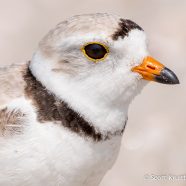Brown Thrasher Visit
This Brown Thrasher came to my feeders today! Talk about a welcome visitor…it ended up spending the day eating with various feathered friends, using that long bill to dig seed out of the snow. It was a delightful surprise for one of the more quiet times of the year. Scott Kruitbosch Conservation & Outreach Coordinator
Read MoreDark-eyed Junco
The Dark-eyed Junco (Junco hyemalis) is one of our most familiar backyard feeder birds. They are a species we can find year-round as they nest in some of our woodlands in western New York. They used to be known as the “snowbird” likely because of their abundance in pouring down from the north into all of the continental United States during the winter. Their plumage, grays and browns above with white below, also seem to fit so perfectly on a snowy landscape. This bird was photographed during a recent snowstorm looking regal as can be while living up to its name. Have you ever...
Read MoreBobcat
They say any evening you spend with a Bobcat is a good evening – okay, maybe they don’t, but I did, and I do, so here’s a photo of a Bobcat that I took about an hour ago after sunset. What a magnificent creature! We will be buried in snow tomorrow in Connecticut, and I hope it comes back to play then. Scott Kruitbosch Conservation & Outreach Coordinator
Read MoreAAfCW 2017 Training
The Audubon Alliance for Coastal Waterbirds/CT DEEP 2017 monitoring and stewardship season is about to begin! Please see below for details, and please pass this along to any new volunteers you feel would be interested in joining us. We hope all our past monitors will be returning this year after yet another record-setting season in 2017. We can only keep this success going with your help! Spend your summer days at the beach and help protect a federally threatened species! The Connecticut Department of Energy and Environmental Protection and the Audubon Alliance for Coastal Waterbirds are...
Read MoreIpswich Savannah Sparrow
The Savannah Sparrow is a familiar bird to many of us, abundant in our farmlands, fields, grasslands, shrublands, shores, roadsides, and other open habitats. You can find them across the northern U.S. and Canada during the nesting and migration seasons, and you’ll spot them overwintering in the southern U.S. or Mexico. This particular individual looks a little different than your average Savannah Sparrow – notice anything unusual? It is somewhat larger and heavier that a typical Savannah Sparrow, and its brown shades and yellow eye spot are considerably paler. This is an...
Read More








